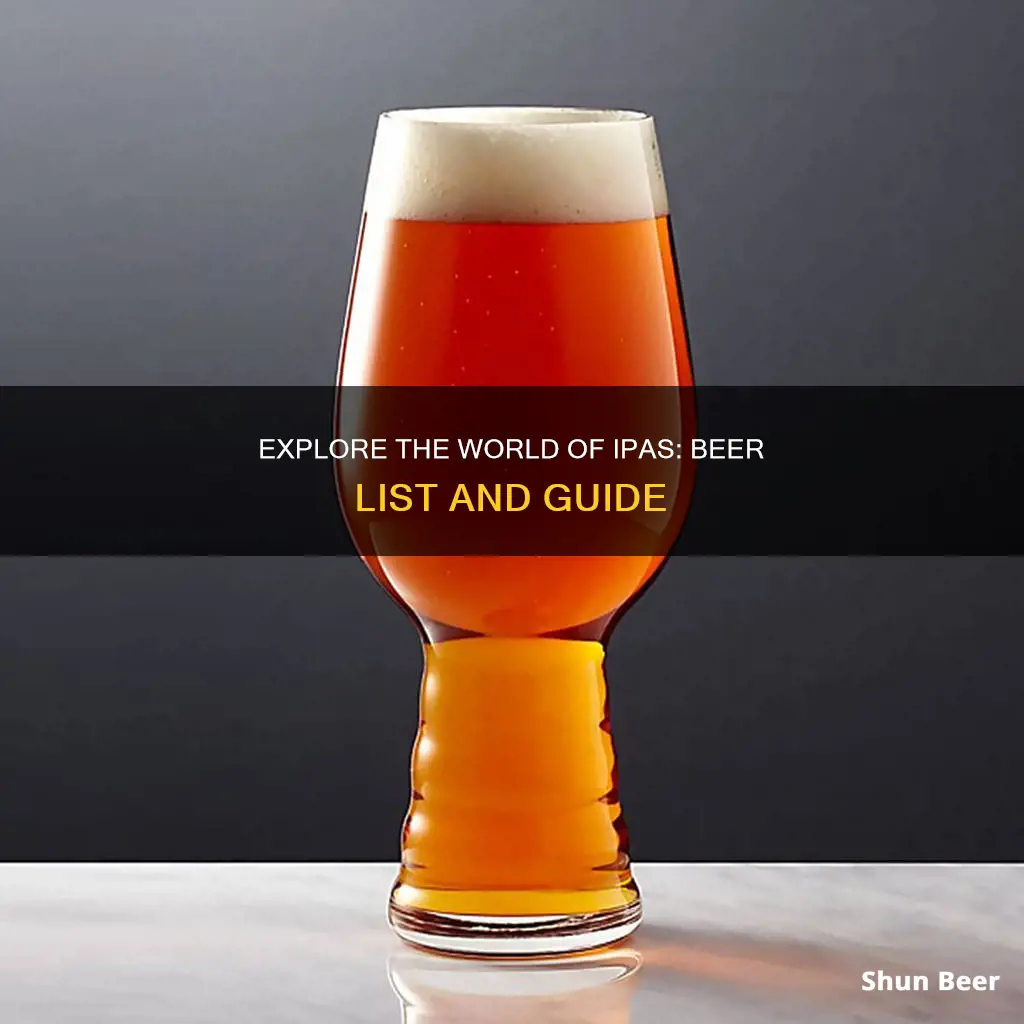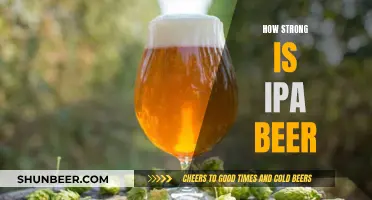
Indian Pale Ale, or India Pale Ale, is a style of beer that is known for its hoppy flavour. The name IPA is derived from its full form, Indian Pale Ale, and it has an interesting history dating back to the 18th century. The beer was supposedly first brewed in the UK in the 1780s and became popular among British soldiers and sailors serving in India. The beer was brewed to withstand long voyages and the hot, humid temperatures in India.
| Characteristics | Values |
|---|---|
| Full Form | India Pale Ale or Indian Pale Ale |
| Origin | British sailors on their long voyages to India in the 18th century |
| Flavour | Hoppy, fruity, bitter, citrusy |
| ABV | 4-10% |
| Types | English IPA, West Coast IPA, East Coast IPA, Double IPA, Triple IPA, Session IPA, New England IPA, etc. |

History of IPAs
The India Pale Ale (IPA) was allegedly invented by the British during their colonisation of India. The beer they sent to their troops kept spoiling during the long sea voyage around the Cape of Africa. The extreme temperatures and prolonged storage without refrigeration were less than ideal for transporting beer.
Brewers had two tools to work with: alcohol and hops. Both act as preservatives. According to legend, it was George Hodgson of East London's Bow Brewery who created the first IPA. It was bitter and highly alcoholic, but it could make the long ocean trip.
By the 1760s, breweries learned that adding extra hops to all of their beers helped fortify them for the voyage to warmer climates. Not only were they adding hops to pale ales, but also porters and ales.
While George Hodgson may not have been the first brewer to come up with the concept, he was the first to achieve a large amount of distribution in India. The Bow Brewery was popular with East India Company traders thanks to the brewery's proximity to the company's docks, as well as the fact that Hodgson sold the beer with an 18-month credit line.
The first known recorded mention of the phrase "India Pale Ale" came in 1835 in an edition of the Liverpool Mercury. Beer drinkers in England eventually got to taste this export style of pale ale by the 1830s, and by 1840, IPA became one of England's best-selling beers.
The popularity of IPAs waned in England by the start of the 20th century as new styles entered the market, and taxes on higher-gravity beers increased. However, the story of IPA was revived by early craft brewers in America during the 1970s and 1980s. They revived the original recipes created 150 years earlier in England while adding new styles of hops. This led to the various styles of IPA that we enjoy today.
The Mystery Widget in Guinness Beer
You may want to see also

IPA meaning
The acronym IPA stands for Indian Pale Ale or India Pale Ale. The beer style dates back to the 18th century when British sailors were looking for a beer recipe that would be easy to preserve on long voyages from Britain to India. The hot and wet weather in India was not conducive to brewing good beer. Thus, the India Pale Ale was born—a beer with lots of hops that could survive long journeys without spoiling.
The IPA has come a long way since its colonial origins, but the hoppy quality has largely remained the same. Today, IPAs are known for their characteristic hoppy flavour, with plenty of citrus and fruit notes. They also tend to have a higher ABV (alcohol by volume) than most other types of beer, typically ranging from 7% to 10%. However, Session IPAs are designed for casual drinking and have a lower ABV of around 4% to 5%.
There are several different types of IPAs, each with its distinct flavour profile and ABV. The English IPA is the original style, with a more subtle aroma and earthy flavour compared to its American counterparts. West Coast IPAs, first crafted in California, have a flavour similar to English IPAs due to the use of crystal malt, making them less dry. East Coast IPAs use varieties of mutated British yeasts and fresh ingredients to produce the intense hoppy and fruity flavours commonly associated with American IPAs.
Double IPAs, also known as Imperial IPAs, have more malts and hops to balance out the sweetness, resulting in a higher alcohol content. Triple IPAs take it a step further with even more hops, making them dryer and more bitter. They can reach extremely high ABV levels of up to 18%, making them popular among seasoned beer drinkers.
In conclusion, the IPA is a style of beer that emphasises hop flavours and aromas. While the traditional IPA was developed to withstand long journeys during colonial times, modern IPAs offer a wide range of flavours, aromas, and alcohol content, making them a popular choice among beer enthusiasts.
IPA Beer Food Pairing: Delicious Combinations to Try
You may want to see also

IPA characteristics
India Pale Ale (IPA) is a hoppy beer style within the broader category of pale ale. The original style of IPA is a British IPA, which is a hoppy golden ale that uses exclusively British hops like fuggles and goldings for a grassy, earthy, and light citrus character. They are usually around 6-7% ABV and dry.
The American India Pale Ale is a younger style of beer, with a history spanning only about 30 years. It is characterized by floral, fruity, citrus-like, piney, or resinous American-variety hop characters. The colour ranges from burnt gold to orange-tinted copper, and it will be clear unless dry-hopped and unfiltered. The aroma will be prominent, occasionally very intense, with citrus, floral, and fruity characters, sometimes bordering on perfume-like. The body will be smooth and medium-bodied with moderate-to-medium carbonation.
The American IPA is often divided into two categories: East Coast and West Coast. West Coast IPAs tend to be more aggressively hopped, with a powerfully bitter flavour profile. Classic Northwest hop flavours like citrus, pine, florals, and strong bitterness are characteristic of this style. In contrast, East Coast IPAs are more balanced, with a stronger malt component that matches the stronger hops. They still have the pleasant bitterness characteristic of IPAs but it is rounded out by a balancing, slightly sweet, clean malt.
Belgian IPAs are a recent hybrid style inspired by the popularity of American IPAs. They are heavily hopped, often with American hop varieties, and may be made with a variety of malts. However, they are differentiated by the use of Belgian yeast strains in bottle conditioning. These IPAs may be more or less cloudy, with a dry, assertive bitterness that pierces through the malt and yeast-derived flavours.
English IPAs, also known as British IPAs, are less intensely hoppy than American IPAs, with more of a balance between malt and hop flavour and bitterness. They may showcase some toasty and bready malt notes, and English yeast may give a more estery fruitiness.
Double IPAs, also known as Imperial IPAs, are stronger and very hoppy variants of IPAs with alcohol content typically above 7.5% ABV. They have a higher amount of ingredients used, particularly hops, resulting in a beer that is higher in alcohol and richer in hop character.
Black IPAs, also known as Cascadian Dark Ales, have the bitter hoppy flavours of other IPAs but with the addition of roasted malts that lend chocolate, coffee, and other dark notes to the overall flavour. They are not heavy or sweet but are dark and intense and often quite strong.
Guinness Book and Beer: Any Connection?
You may want to see also

IPA types
There are many types of IPAs, with new varieties being crafted all the time. The Beer Judge Certification Program (BJCP) currently identifies nine distinct types of India Pale Ale. However, there are many more sub-styles and variations.
British/English IPA
The original style of IPA, from which all others stem, is a hoppy golden ale that uses exclusively British hops, such as Fuggles and Goldings, to give it a grassy, earthy, and light citrus character. They are usually around 6-7% ABV and have a very dry finish.
West Coast IPA
Invented in California, this style takes its inspiration from British IPAs but uses American "C" hops, such as Cascade, Citra, and Chinook, to give it a huge citrus aroma with hints of pine. They tend to be less dry and significantly more bitter than British IPAs.
East Coast IPA
A fairly new style, the East Coast IPA is based on the West Coast variety but uses mutated, complicated British yeasts, which produce lots of flavours and aromas as they ferment the sugar. You will usually detect notes of stone fruit, banana, and tropical fruit. This flavour boost means fewer hops are needed, making the beer less bitter but cloudier and hazier in appearance.
Double/Imperial IPA
Double or Imperial IPAs are a result of brewers and drinkers getting used to the high bitterness of regular IPAs and wanting more hops. To balance this out, brewers used more malt, which created a higher alcohol content. These beers have a strong hop flavour with floral, piney, and citrus notes and typically have an ABV of 7.5% or higher.
Session IPA
Session IPAs are a much lighter style of IPA, with a more balanced bitterness and an ABV that never goes above 5%. They are brewed to be enjoyed in multiple beers in one sitting or "session".
Black IPA
Also known as a Cascadian Dark Ale, Black IPAs are a unique style that aims to create a beer that looks like a stout but has the hoppy aroma of a typical IPA. The darker malts lend roasted flavours that contrast with the floral, citrus, and piney flavours of the hops.
Belgian IPA
Belgian IPAs typically use a Belgian-style yeast, which gives the brew clove and spicy notes. They tend to be lighter in colour, with a more complex flavour and higher alcohol content than a typical IPA.
Grapefruit IPA
A variation of a fruited IPA that has become so popular it warrants its own category. The aroma and flavour come largely from grapefruit, which also lends acidity and amplifies the bitterness.
New England/Hazy IPA
New England IPAs, also known as hazy IPAs, are cloudy in appearance and have a smooth, citrusy flavour. They are less bitter than other styles and typically have an ABV of 6-7.5%.
Milkshake/Lactose IPA
Milkshake IPAs are brewed with lactose and often fruit purée, giving them a richer, thicker, creamier body that balances the sharpness of the hops and heightened alcohol.
Sour IPA
Sour IPAs are made through a unique fermentation process that uses a combination of regular yeast and natural yeast that develops organically. They have a puckery flavour profile and are less bitter than other IPAs, with various levels of sweetness, fruitiness, and haze.
White IPA
A White IPA is a combination of a witbier with a standard IPA. It typically has a pale, hazy appearance and offers Belgian aromas and flavours of bananas, cloves, and coriander, alongside a healthy dosing of hops.
The Acidic Nature of IPAs: Beer's Sour Side
You may want to see also

IPA vs regular beer
India Pale Ale (IPA) is a type of pale ale, which falls under the broader category of ales. Ales are created through top fermentation, where yeast ferments at warmer temperatures of 65 to 72 degrees Fahrenheit, and settles at the top of the beer. This is in contrast to lagers, which are bottom-fermented at cooler temperatures of 45 to 55 degrees Fahrenheit. Ales tend to have a fruitier taste and a thicker layer of foam than lagers.
IPAs tend to have a stronger flavour than regular pale ales, with a higher alcohol content and a harsher hops flavour. However, there is no official standardisation for when a pale ale becomes an IPA, and the taste can vary depending on the brewer's method and ingredients. IPAs are known for their strong, hoppy flavours and can be bitter, with high alcohol levels. They often have citrus, herbal, or fruity flavours.
The main difference between an IPA and a lager is in their fermentation process and hop profile. IPAs are top-fermenting beers brewed at higher temperatures, while lagers are bottom-fermenting beers brewed at lower temperatures. IPAs use traditional English malts or dried grains, while lagers typically use pale or Pilsner malts.
The fermentation process also affects the colour of the beer. Lagers have a lighter, slightly hazy colour due to the bottom-fermenting yeast, while IPAs have a deeper amber hue from the higher amount of hops in the beer.
In terms of alcohol content, a typical lager averages about 5% ABV, while IPAs can reach as high as 10-15% ABV for double and triple IPAs. IPAs also tend to have higher International Bitterness Unit (IBU) values due to the higher amount of hops used in brewing.
When it comes to food pairings, IPAs go well with rich and creamy foods like cheese, grilled or roasted meat, burgers, pizza, and hot dogs. Lagers, on the other hand, pair well with shellfish, grilled chicken or pork, and Mexican food.
The High Price of Guinness Beer: Is It Worth It?
You may want to see also
Frequently asked questions
IPA stands for Indian Pale Ale or India Pale Ale.
The history of the IPA dates back to the 18th century. Legend has it that these types of beer were made for British sailors on their long voyages to India.
IPA is a style of beer, which is popular enough these days to be called "regular" beer. It is a type of pale ale but is made with more hops, to give it a stronger flavour.
There are several types of IPAs, including English IPA, West Coast IPA, East Coast IPA, Double IPA, Triple IPA, and Session IPA.







